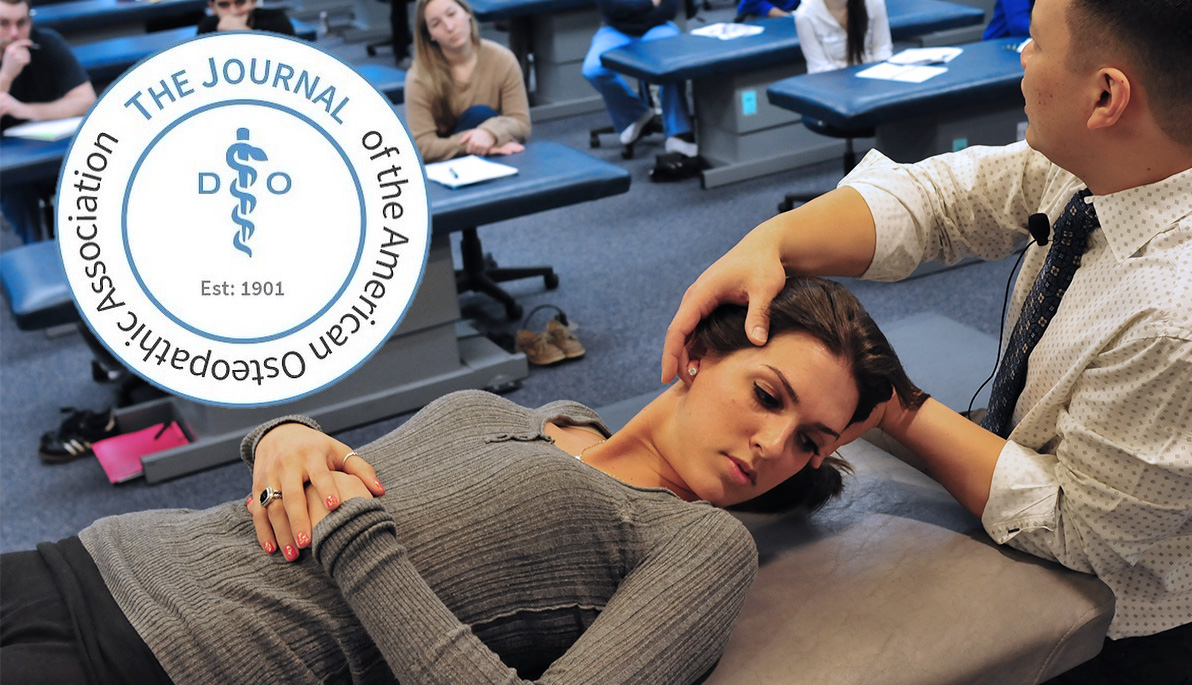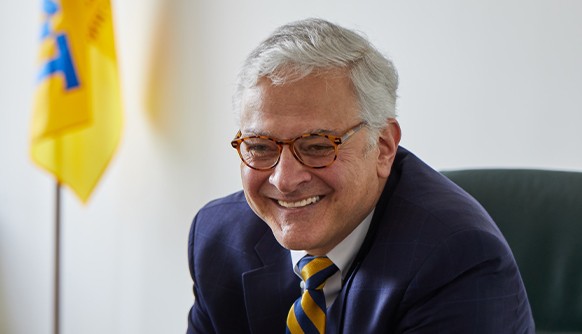News
Getting Hands-On with Concussions
September 4, 2020
Pictured: Sheldon C. Yao, D.O., demonstrates osteopathic techniques.
The Centers for Disease Control estimates that approximately 3.8 million concussions occur during competitive sports and recreational activities in the United States each year. However, as many as 50 percent of these concussions may go unreported.
Experts believe that vague symptoms that can be attributed to other factors and patients’ unawareness about warning signs may be to blame. However, not identifying and treating a concussion as early as possible can cause symptoms to linger long after the initial injury. As many as 25 percent of concussion patients experience post-concussive symptoms such as headache, dizziness, neuropsychiatric symptoms, and cognitive impairment one year after the initial injury, which is why early intervention is critical.
As seen in the Journal of the American Osteopathic Association, three articles based on recent studies conducted at NYIT College of Osteopathic Medicine (NYITCOM) explore whether osteopathic techniques can improve concussion symptoms and help clinicians to better understand the impact of these injuries. The following articles were written on data collected by the health professionals at NYITCOM’s Kenneth W. Riland Academic Health Care Center.
Following a head injury, clinicians often instruct the patient on concussion warning signs to help the individual identify and report symptoms. Through this educational counseling, patients with a concussion are advised to avoid excessive screen time and other stimuli, such as loud music before bed, and to rest as much as possible to help reduce symptoms. Currently there are limited treatment options other than educating the patient post-concussion.
NYITCOM researchers wanted to investigate whether Osteopathic manipulative treatment (OMT) was a better option to educational counseling as a way to improve a patient’s concussion symptoms. OMT is the hands-on technique used by osteopathic physicians (D.O.s) to diagnose, treat, and prevent illness or injury. During OMT, a D.O. moves a patient’s muscles and joints using techniques that include stretching, gentle pressure, and resistance. These techniques are also used to help patients find relief from conditions such as muscle pain, migraines, and carpal tunnel.
The team analyzed 31 patients with concussion-like symptoms from a head injury that occurred in the previous seven days. Study participants were split randomly into two groups, with 16 patients receiving OMM and 15 receiving concussion education intervention. The researchers then assessed both groups to quantify the number of each patient’s symptoms, as well as their severity. The results found that the OMM intervention group saw greater improvement, with a decrease in the number of both concussion symptoms and severity, as compared to the concussion education group. Additional studies were recommended to further explore OMT for concussion.
Investigators included Department of Osteopathic Manipulative Medicine Chair and Professor Sheldon C. Yao, D.O., Medical Director Hallie Zwibel, D.O., NYITCOM alumna Nicole Angelo (D.O. ’19), Assistant Professor and Director of the Parkinson’s Disease Treatment Program Adena Leder, D.O., and Assistant Professor Jayme Mancini, D.O., Ph.D.
Many concussion patients experience poor sleep quality, which can prolong their recovery and delay return to normal activities. However, OMT may play a critical role in managing the overall healing process.
Investigators studied whether OMT or education counseling improved sleep quality in student-athletes with concussion. The project looked at 30 student-athletes with no medical history of neurodegenerative disease following a sport-related injury. Participants received OMT intervention or standard counseling on how to care for a concussion during their first and second visits and then rated their symptoms, including sleep quality, before their treatment and between visits.
The 16 participants who received OMT reported 80 percent and 76 percent improvement in sleep quality from their second and third visits, respectively. Participants who had an educational intervention reported a 36 percent and 46 percent improvement from pre-OMT values to their second and third visits, respectively. However, given that the study was conducted with a small population, the researchers recommend further studies with larger populations.
Researchers included NYITCOM student Diane Moya, Samantha Mazzeo (D.O. ’20), Craig Silverberg (D.O. ’20), Tiffany Oommen (D.O. ’20), Nicole Angelo (D.O. ’19), and NYITCOM faculty investigators Hallie Zwibel, D.O., Jayme Mancini, D.O., Ph.D, Adena Leder, D.O., and Sheldon C. Yao, D.O.
“Cranial Strain Patterns Associated with Concussions”
The traumatic forces that cause concussion can also cause changes in the head’s musculoskeletal structure, known as cranial somatic dysfunctions. These dysfunctions may restrict natural movement in cranial bones and soft tissue, affecting the flow of the cerebrospinal fluid, which cushions the brain and spinal cord.
This study investigated whether patients were more likely to have cranial somatic dysfunctions as a result of concussion. Data was collected from 16 college athletes, six with physiologic cranial somatic dysfunctions (musculoskeletal changes from everyday life) and 10 with non-physiologic cranial strain somatic dysfunctions stemming from injury or illness. The athletes were also given questionnaires to note their concussion force vector (the direction that the force impacted their head).
To determine the strain patterns of each athlete’s somatic dysfunction, D.O.s used an OMT hand positioning known as the Vault Hold, which allows the physician to feel the cranium and detect musculoskeletal issues. Using neurocognitive testing software, the researchers then analyzed the data gathered during OMT to determine whether concussion sufferers were more likely to have dysfunction resulting from concussion, and if certain vector forces may be linked to different strain patterns.
The study could not find statistically significant evidence to show that concussion patients were more likely to have non-physiologic cranial somatic dysfunctions compared with physiological cranial somatic dysfunctions. However, non-physiologic cranial somatic dysfunctions did seem to be linked to concussion. The athletes who experienced head injuries where forces struck the head from front to back were 1.5 times more likely to have non-physiologic cranium injuries than athletes who experienced force from the side. The investigators concluded that further studies are needed to better understand the potential association between concussion and cranial somatic dysfunctions.
Researchers included NYITCOM medical student Lauren Schwartzberg, Nicole Angelo (D.O. ’19) and Lilit Aslanyan (D.O. ’20), and faculty Jayme Mancini, D.O., Ph.D., Associate Professor of Osteopathic Manipulative Medicine Patricia S. Kooyman, D.O., Associate Professor of Osteopathic Manipulative Medicine Reem Abu-Sbaih, D.O., Hallie Zwibel, D.O., and Sheldon C. Yao, D.O.





